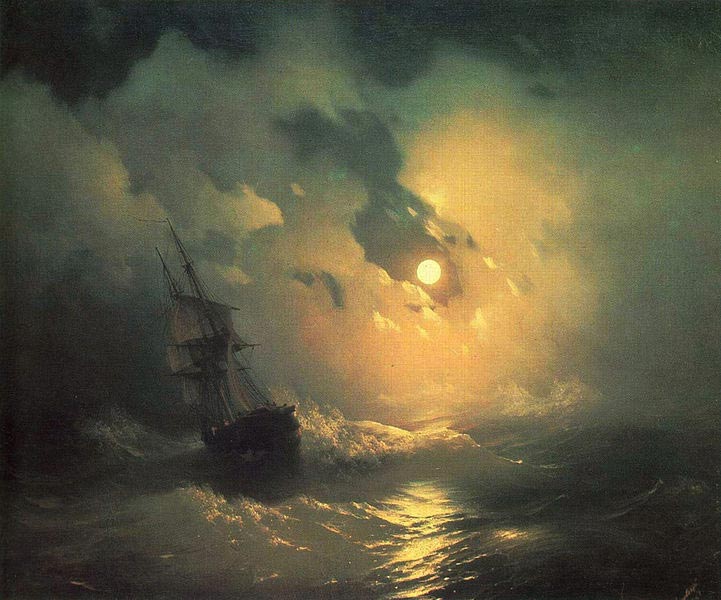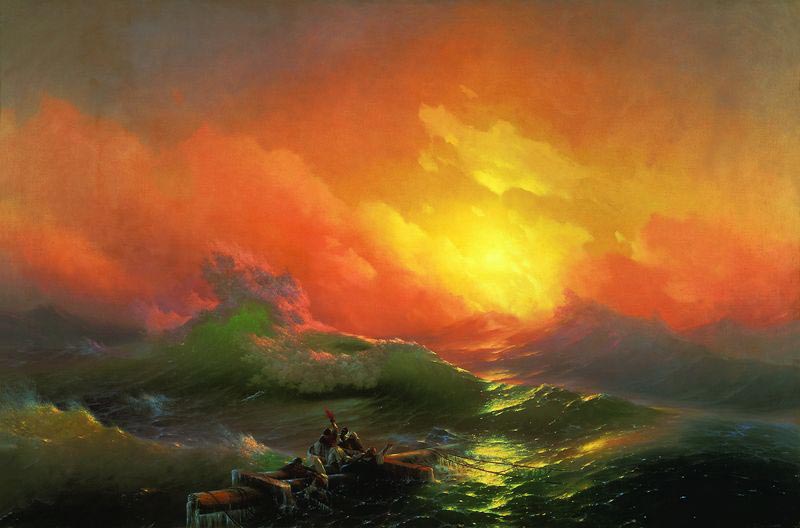| Ivan Aivazovsky | |
|---|---|
 |
|
| Born | July 29, 1817 Feodosiya, Crimea |
| Died | May 5, 1900 (at age 82) Feodosiya, Crimea |
| Nationality | Armenian Russian |
| Movement | Romanticism |
| Field | Painting, Drawing |
| Works | View Famous Paintings |
One of the most fascinating and richly talented artists of the past two centuries was undoubtedly the Armenian-Russian painter Ivan Aivazovsky. Ethnically an Armenian, he was born the city of Feodosiya which was then a part of the Russian Empire. Today Feodosiya is a port city in the Crimean Ukraine.
Although Aivazovsky was born in 1817 into a poor family, his father did an amazing job of providing him with a high quality education, teaching him to speak several languages fluently. The young Aivazovsky also showed extraordinary artistic potential from an early age, which proved to be his ticket to a future life of wealth and fame as one of Europe’s most brilliant artists.
Aivazovsky earned a seat in the Simferopol gymnasium No. 1. His most important training came in Russia’s St. Petersburg Academy of Arts – his raw talent was his payment for a first-class education.
Possibly the Best Seascape Artist
Ivan Aivazovsky is by far most known for painting magnificent seascapes, and is considered to be among the best in this category, perhaps “the best” all of history. Fully half of all his life works, which were many, depict ocean scenes with ships, magnificent sunsets, cloudscapes, ships and waves.
This talent earned him a huge amount of work from the Russian Navy. For them he painted numerous images of the sea and ships – a commission which would keep his income flowing and earn him many important connections with powerful people.
Vast Influence throughout Europe
 Aivazovsky was able to travel widely in his long life of 82 years. One of the most significant locations for him would be Istanbul in modern-day Turkey. There he received a number of commissions from the Sultans of the Ottoman Empire. Many of his paintings are still on display today in the magnificent palaces of the former Ottoman rulers.
Aivazovsky was able to travel widely in his long life of 82 years. One of the most significant locations for him would be Istanbul in modern-day Turkey. There he received a number of commissions from the Sultans of the Ottoman Empire. Many of his paintings are still on display today in the magnificent palaces of the former Ottoman rulers.
His association with the Ottoman Turks would prove to be one of the most painful associations of his life considering that he was Armenian, and that his ethnic group suffered a horrific and violent purge at the hands of the Turks near the end of the 19th Century.
Agony of Genocide
By this time, Aivazovsky was well into his senior years, but he was still very much engaged as an artist and politically with the dreadful situation that fell upon his fellow Armenians.
He painted several works which portrayed the agony of his people as they suffered a near-genocide, which included the Hamidian Massacre of 1895.
Magnificent Use of Light
 Ivan Aivazovsky’s paintings are noted for their magnificent use of light against waves and sea foam, which still causes art critics to marvel at his eye, skills and temporal insights. Most of his paintings were of coastal scenes which were imbued with a richly romantic flair. He not only ingeniously incorporated sunlight interacting with sea waves, but also moonlight, fire, clouds, mists and fogs.
Ivan Aivazovsky’s paintings are noted for their magnificent use of light against waves and sea foam, which still causes art critics to marvel at his eye, skills and temporal insights. Most of his paintings were of coastal scenes which were imbued with a richly romantic flair. He not only ingeniously incorporated sunlight interacting with sea waves, but also moonlight, fire, clouds, mists and fogs.
Other favorite subject matters for Aivazovsky were scenes of the Ukrainian countryside featuring the work and activities of peasants and small rural towns. He also painted rural scenes in the outlying areas of Istanbul.
Despite his almost universally recognized and accepted genius, some art critics have complained that Aivazovsky did not vary his themes enough, and that many of his seascapes could appear repetitive, especially after one views hundreds of them. He has also been called melodramatic and perhaps given to oversentimentality.
Last Influence
Aivazovsky was easily the most prolific European painter of high caliber in Europe. He was elected to no less than five prestigious Art Academies, including those in St. Petersburg, Rome, Florence and Amsterdam. The depth of this achievement cannot be overstated considering that these art institutes were among – and still are — the most magnificent in the world, and bear centuries of tradition.
In his later years, Aivazovsky established as art school in the city of his birth, Feodosiya. When he died in 1900 at age 82, he left behind an astounding 6,000 paintings. Many of these can be found throughout Europe today. Also, Aivazovsky’s works have stood the test of time. Some of his paintings have been recently sold at art auctions, commanding enormous values of $5 million to $10 million.
In 1977, an asteroid was named after him by a Soviet astronomer. Aivazovsky has been referenced in a poem by Anton Chekhov and has even had postage stamps issued in his honor in Russia, Armenia and the Ukraine. Thus, Ivan Aivazovsky is an artist who can now be considered among the “immortals.”